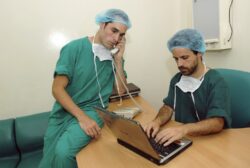The plan hopes to create 3,000 ‘virtual beds’ (Picture: Shutterstock)
Thousands of patients will get emergency advice by video call instead of going to A&E to ease pressure on overstretched hospitals.
Elderly and vulnerable people recovering from falls or who are frail will also be monitored remotely or have daily visits, the health secretary said.
The plan, revealed today, aims to create 3,000 ‘virtual beds’ by next winter, with around 50,000 people a month cared for at home.
Stephen Barclay said: ‘While there is no quick fix, we can take immediate action to reduce long waits for urgent and emergency care.
‘By expanding the care provided in the community, the most vulnerable, frail and elderly patients can be better supported to continue living independently or recover at home.’
Health secretary Stephen Barclay hopes the initiative will help people to recover at home instead of a ward (Picture: Rex)
‘Not only will patients benefit from better experiences and outcomes, it will ease pressure on our busy emergency departments.’
The NHS is struggling with walkouts by nurses and paramedics in disputes over pay and conditions, as well as the backlog of cases after the pandemic.
Latest data shows ambulance handover delays outside hospitals in England have dropped to their lowest level this winter, but one in five patients still waits at least half an hour to be transferred to A&E. Mr Barclay suggested ‘up to 20 per cent of admissions are avoidable with the right care in place’.
The department of health said the plan builds on existing virtual wards.
But shadow health secretary Wes Streeting accused ministers of ‘watering down standards’ and said, even if the NHS meets their targets, ‘patients will be left waiting longer than is safe’.
Get in touch with our news team by emailing us at [email protected].
For more stories like this, check our news page.
There’ll be 3,000 ‘virtual beds’ by next winter.





